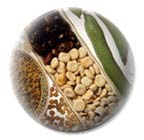- Home
- Introductions

|
Vegetable Seed Production: AsparagusYou are here: Seed Production: Liliaceae: Asparagus
Botany Plant Characteristics One of several edible species in the genus. Asparagus is a perennial, dioecious, monocot plant that produces new above ground stems each year from a fleshy underground "crown." Mature asparagus plants tolerate a wide range of environmental conditions but newly emerging "spears" are easily damaged by frost, thus asparagus is generally considered a cool season crop.
Occasionally, perfect flowers may appear on male plants.
The crown according to Blasberg (1932) is not a typical rhizome but consists of unelongated basal internodes of old stems. Increase in size of the crown results from development of buds both apical and lateral. The development of the latter cause a branching of the crown.
New roots develop from the bases of actively growing buds. The roots are very thick and fleshy and are the primary food storage organs of the plant. The large roots have a heavily suberized epidermis, but a few root hairs may be present. The bulk of the mass of the root is loosely fitting cortex, which through division gives a considerable increase in diameter. On the crown are located many buds, each potentially capable of producing an upright stem. According to Tiedjens (1926) there is a regional inhibition in the crown in the vicinity of the growing spear, preventing the sprouting of adjacent buds until the spear is removed. Each bud is developed in the axil of the one preceding it. The buds just before elongation contain the spear in its miniature form, i.e., most of the differentiation occurs prior to elongation.
The small bracts at each node of the spear are actually the true leaves but are not photosynthetically active. The photosynthetically active organ of the asparagus fern is the cladophylls which are actually modified stems. Soil Nutrition Loams, sandy loams, and sands are generally preferred for asparagus production. Soils for a permanent asparagus planting should be deep, well drained, and friable to allow development of the expansive root system. The field should not have been planted in asparagus for at least four years previously, especially if there is a history of fusarium wilt. Isolation 1 mile for hybrid seed Planting Plantings are established from crowns, transplants, or direct seeding. Commercial growers rarely direct-seed asparagus. Asparagus crowns or transplants are grown by nurseries that specialize in crown or transplant production.
For the production of crowns, seeds are sowed usually in sterilized or fumigated seed beds with a linear spacing about one foot apart. The crowns are dug from the seed bed and sold usually when they are 2 years old although 1 year old crowns are sometimes sold as well. In the Eastern US, two year old crowns are generally planted in productions field in furrows so that the tops are at least 6 to 10 inches below the surface. The furrow is gradually filled in as the crowns develop. Ten to fifteen week old transplants are more commonly used in the Western states where they establish better due to the longer growing season. Transplants are grown in greenhouses using plug trays and transplanted into the field in early spring. They are transplanted into a furrow that is gradually filled in with soil as the season progresses. Irrigation Asparagus has a deep extensive root system and is often not irrigated except during establishment or extreme drought. In areas with seasonal rainfall like California or Washington the crop is sprinkler irrigated periodically during the dry season. Roguing Agronomic characteristics for selection: earliness, spear uniformity, deep green smooth spears and tight headedness. Male hybrids produce more yield, have more longevity and can have disease tolerance. (Fusarium redolans and F. monoliforme)
Seed Harvest
When the berries are red they are harvested (fall), then dried, mashed, and thrashed to separate the seeds from the chaff, then soaked 1 - 2 days in water to separate the skin and pulp. Harvest begins in the second year but good yields are from the fourth year. Cleaning
After harvesting, seeds are separated by weight in water. Heavy seeds, that go to the bottom are selected, while light seeds are discarded. Seed Yield 1121 kg / ha (1000 lb/acre) to 1569 kg / ha (1400 lb/acre)
Seed Identification:
|
||||||||||||||||||||||||